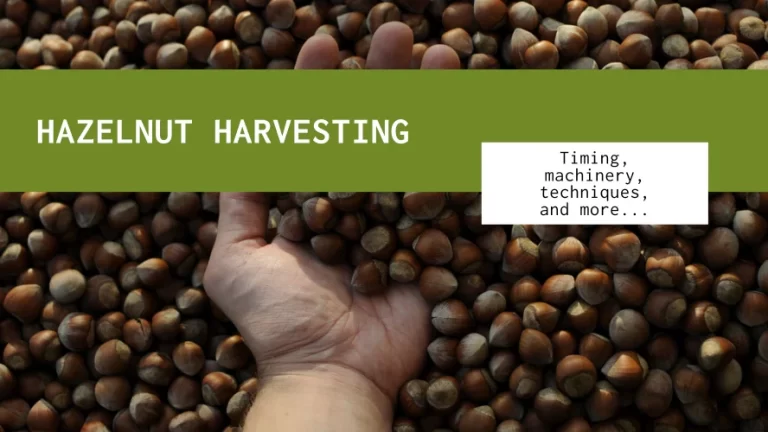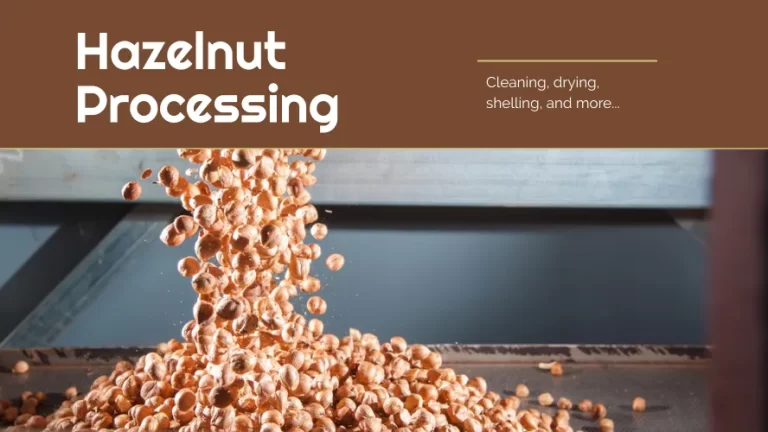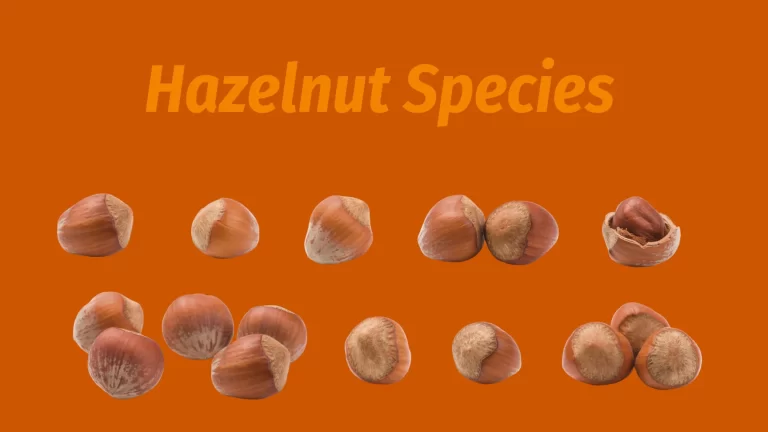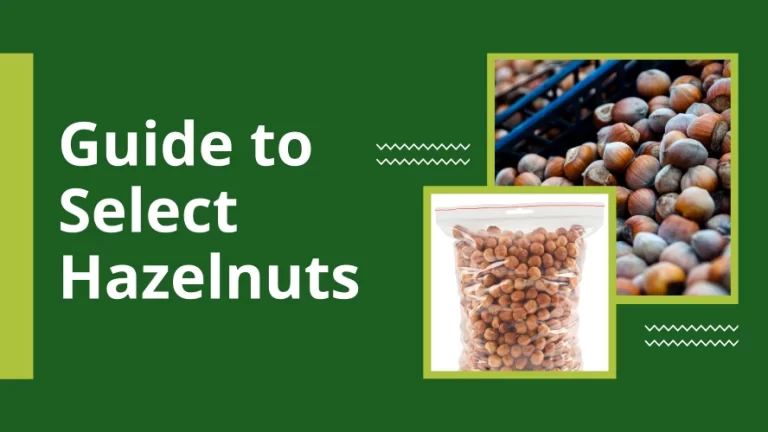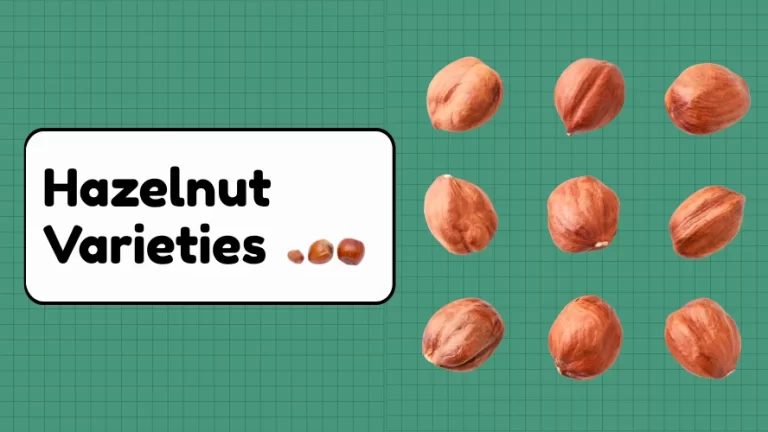How to Forage Hazelnuts

Foraging hazelnuts is a hands-on way to connect with nature and enjoy one of its most delightful offerings. Before modern machinery took over, this was the primary method of gathering these nuts. Communities often gathered during harvest, sharing techniques and enjoying the collective effort.
Venturing into hazelnut groves requires a keen eye for spotting ripe nuts and a gentle hand to harvest them without causing damage. For those who’ve tried it, the experience is not just about collecting nuts. It’s an opportunity to immerse oneself in nature, appreciate the sounds of the outdoors, and continue a tradition that has been passed down through generations.
Curious about embarking on this journey yourself? Join us as we explore the process of handpicking hazelnuts in the wild.
Why Do People Forage Hazelnuts?
Foraging hazelnuts is like opening a door to a world of simple pleasures. But why do people still venture out to gather these natural treasures by hand in this age of convenience?
- A taste unlike any other: Wild hazelnuts have a distinct flavor, a blend of the soil they sprout from and the wild air they breathe. Handpicked nuts taste fresher and richer, rewarding the forager’s effort.
- Nature’s Therapy: There’s something therapeutic about wandering through the woods, listening to leaves whisper, and being in the moment. It’s a break from the digital world, a chance to reconnect with nature and oneself.
- Sustainability: Handpicking ensures that only the ripe nuts are taken, leaving the younger ones to mature. It’s a gentle approach, respecting nature’s pace and minimizing harm to the environment.
- Quality and precision: It allows foragers to be selective. You can ensure that only the finest and ripest hazelnuts are chosen. This precision often results in a higher-quality yield, free from imperfections that machines might overlook.
- A nod to tradition: While many of us today might not rely on foraging as people once did, harvesting hazelnuts from the wilderness keeps us connected to rich cultural traditions. For example, for Native Americans, hazelnuts were not just a food source but held deep cultural and spiritual significance. By continuing this practice, we honor their legacy and the shared human experience of cherishing nature’s bounty.
When to Forage Hazelnuts?
Foraging hazelnuts is a rewarding adventure, but as the saying goes, timing is everything. If you venture out too early, you might find unripe nuts, and if you wait too late, the local wildlife might have already had their feast. So, when’s the golden window for hazelnut picking?
The ideal climate and season
Hazelnuts have a sweet spot when it comes to their ripening season. In most regions where these nuts flourish, the months to mark on your calendar are typically August and September. As summer gives way to autumn and the days balance warmth with a cool edge, hazelnuts reach their prime.
Climate plays a pivotal role in this. Hazelnuts thrive in areas with mild summers followed by cool, moist autumns. This balance of warm days and chilly nights allows them to develop their signature rich, buttery flavor.
And a quick tip from someone who’s been out there: wildlife, especially squirrels and birds, have a keen sense of when these nuts are ready. To ensure you get your share, watch the trees as summer progresses, and be ready to head out once you notice the first signs of ripening.
Regional variations
For those in California, beaked hazelnuts can be spotted as early as the end of July. Different regions and hazelnut varieties can exhibit slight shifts in their ripening schedules, so staying informed about your local species is always beneficial.
Preparing for Your Hazelnut Harvest Adventure
Before we discuss the foraging techniques, let’s familiarize ourselves with our main subjects: the beaked hazelnut (Corylus cornuta) and the American hazelnut (Corylus americana). Both are wild varieties native to North America, each with distinct characteristics. Their unique growth patterns and differences in texture will shape our handpicking approach.
Interestingly, the beaked and American hazel shrubs look similar, but their nuts tell a different story. As illustrated below, the beaked hazelnut boasts a tubular involucre covered in spines, whereas the American hazelnut features a shorter, less pronounced husk.

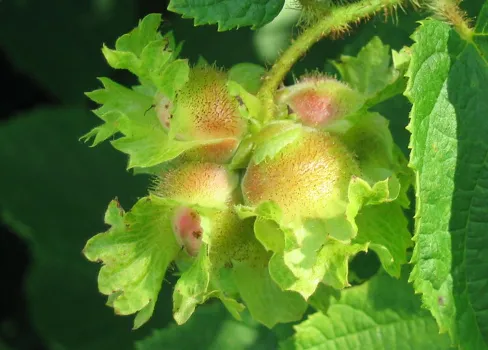
Picking Strategy: Tree or Ground?
A piece of advice from someone who’s been out there: for both these species, it’s often best to harvest hazelnuts directly from the tree rather than waiting for them to drop. The reason? If you delay, you might discover that local wildlife got there first. Nature waits for no one, and a proactive approach is key.
Where to look for wild hazelnuts?
Knowing where to look is very important if you’re new to hazelnut foraging. While you might envision towering trees when thinking of hazelnuts, both the beaked and American hazelnuts predominantly grow as shrubs or small trees.
During your foraging trip, remember to scan the understory vegetation and not just look upwards. Keep an eye out for bushes and shrubs. Their growth at lower heights means you can easily spot and pick these delightful nuts.
Eating Fresh vs Drying First
While it’s possible to eat hazelnuts right off the tree, both species offer a much better taste after drying. This stage intensifies their flavor and prepares them for longer storage. Since freshly picked hazelnuts have a high moisture content, drying them can improve their texture and taste. That’s why the upcoming steps will guide you through the drying process.
Equipped with this knowledge, let’s uncover the unique details of gathering each type. We will ensure you’re well-prepared for your hazelnut foraging adventure.
How to Forage Beaked Hazelnuts
Ah, the beaked hazelnut! With its spiky outer layer, this little gem is a wild treat waiting to be discovered. If you’ve ever wandered through North American woodlands during the summer, you’ve likely encountered these unique nuts. Harvesting them is an art, a blend of timing and technique. But with a few pointers, anybody can do it. Let’s dive in!
1. Suit up with gardening gloves
Before anything else, ensure you’re wearing sturdy gardening gloves. The spiny husk of the beaked hazelnut can be pretty prickly. These gloves will make sure you can pick and handle them safely.
2. Picking the right way
While individual hazelnuts are common, you’ll also come across clusters, sometimes two or even three nuts together. When you’re ready to pick, approach with care. Gently twist the nut or the entire cluster away from the branch, ensuring you don’t break any twigs in the process.
3. Drying out
Choose a well-ventilated area, and let the nuts dry for 2 to 3 weeks. This period allows the nuts to mature perfectly. The protective leaves will also dry completely.
4. The final touch
Once dried, it’s time to unveil the prize. With your gloves still on, gently peel away the dried husks. Beneath, you’ll find beautiful brown hazelnuts, nestled safely in their shells.
5. Enjoy
Now, you just have to crack your hazelnuts and enjoy them however you want.
How to Forage American Hazelnuts
The American hazelnut offers a different foraging experience compared to its beaked counterpart. With their smooth involucres, these nuts are a testament to the beauty of nature’s bounty. If you’re keen to embark on an American hazelnut quest, here’s a step-by-step guide to help you along:
1. Timing is crucial

American hazelnuts tend to be ready for harvest after the beaked species. In my experience, the prime time to collect these gems is September.
Look for nuts that are turning a lovely shade of brown, while their protective husk remains green.
Harvesting them too early might result in nuts that haven’t reached their full potential, leaving you with a less-than-tasty treat.
2. Snip, don’t rip
Equipped with gardening scissors, approach the tree and look for clusters brimming with nuts. Gently cut these clusters from the branches.
And a quick tip: a swipe of rubbing alcohol on the scissors’ blades can prevent plant diseases from spreading.
3. Drying
Once you’ve got your treasure, stash the nuts in a well-ventilated spot. A sack or crate works wonders. Over the next 2 to 3 weeks, you’ll notice them drying out and turning a deeper shade of brown.
4. Removing the involucres
It’s time to separate the nuts from their involucres. Thanks to the previous drying step, removing the husks is a breeze. Gently pluck the nuts free and place them back in their container.
5. Drying in direct sunlight
For that final touch, let the hazelnuts bask in the sun for about a week. This completes the drying process and gives them that delicious crunch.
6. Savor
Now, the moment of truth. Crack them open and enjoy.
Storing Your Foraged Hazelnuts
You’ve ventured out, harvested a bounty of hazelnuts, processed them yourself, and even indulged in a few. But now you’re left with a surplus. How do you ensure they remain fresh for future enjoyment? With the right storage techniques, you can savor these nature’s treasures for months to come. Here’s how:
- In-shell storage: Hazelnuts last much longer when kept in their shells, which serve as a natural protective barrier. Only shell the ones you intend to eat and store the rest as they are.
- Cool and dry is key: Hazelnuts maintain their natural oils and freshness best in a cool, dry environment. This also prevents them from turning rancid. Keep them away from direct sunlight, ideally in a pantry or cupboard.
- Seal them tight: Store the hazelnuts in airtight containers. This shields them from pests and retains their freshness. Glass jars with tight-sealing lids are a great choice.
Additional Safety Tips for Collecting Hazelnuts in the Wild
Like any adventure, it’s essential to be prepared and informed when harvesting hazelnuts in untamed areas. Here are some tips to ensure you do it safely.
Stay aware of your surroundings: It’s easy to get lost in the thrill of the hunt, but always be mindful of your surroundings. This includes watching out for wildlife. While most animals are more scared of you than you are of them, it’s good to give them their space.
- Know your plants: Not everything in the wild is friendly. Some plants can be harmful or even poisonous. Before heading out, familiarize yourself with local plant life, especially those you should avoid.
- Dress appropriately: Wear long pants and closed shoes. This protects against scratches, ticks, and other small insects.
Responsible Foraging: Legal, Ethical, and Environmental Considerations
Handpicking hazelnuts is a joy, but it’s also a responsibility. As we tread the paths of woodlands and groves, we must be mindful of our impact and the rules we should follow. Let’s look into some key considerations to ensure our foraging journey is enjoyable and sustainable.
Legal aspects of foraging
Before you set out, it’s crucial to be aware of the local regulations regarding foraging. Some areas might have restrictions to protect native plants or wildlife habitats. Always check with local authorities or park services to ensure you’re allowed to collect hazelnuts. Remember, it’s always better to ask first than to face complications later.
Ethical foraging
Woods and forests are a shared treasure, home to countless creatures and plants. When foraging, always leave enough hazelnuts behind for wildlife and future growth. Think of it as your contribution to the circle of life. Plus, it’s a nod to foraging traditions, where respect for nature was paramount.

Environmental impact
While gathering hazelnuts in the wild has a minimal environmental footprint compared to large-scale harvesting, it’s still essential to tread lightly. Stick to established paths to avoid trampling delicate undergrowth. Always be cautious about where you pick; some areas might be habitats for endangered species or fragile ecosystems.
Don’t Forget About European Hazelnuts!
While our focus has been on the wild wonders of North America, there’s another hazelnut treat awaiting enthusiasts. The European hazelnut, also known as the common hazelnut, doesn’t grow wild like its American relatives. But that doesn’t mean you can’t enjoy the thrill of handpicking them.
Some hazelnut farms in the Willamette Valley offer a unique “U-Pick” experience for those seeking a hands-on harvesting adventure. Though the setting leans more towards a commercial hazelnut harvesting environment, you can still relish the experience of handpicking the European hazelnut. This species is known for its large size and unique flavor.

So, if you ever find yourself in the region during harvest season, don’t miss out on this enchanting detour.
Ending Thoughts
Both beaked and American hazelnuts showcase nature’s diverse riches. In this guide, we’ve taken a significant step toward mastering the art of foraging these hazelnut species.
Foraging is more than just collecting nuts. It’s about immersing oneself in nature, appreciating its rhythms, and connecting with a tradition that spans centuries. It’s the sun warming your skin, the soft rustle of leaves, and the thrill of discovering a perfectly ripe hazelnut.
But as we’ve also learned, with the joy of foraging comes responsibility. It’s essential to approach this activity with respect for nature and understand the ethical and environmental implications. By doing so, we make sure future generations can also enjoy these traditions.
If you’re new to this, I hope you’ll be inspired to embark on your own hazelnut adventure. To those who are seasoned foragers, may you continue to explore, discover, and share your experiences with the community.
Happy foraging, dear reader. May your adventures always lead to bountiful harvests!
